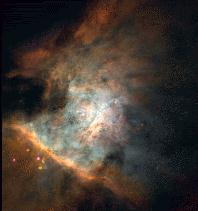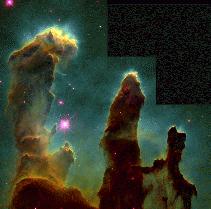

Stars form when giant molecular clouds collapse under their own gravity. When enough mass accumulates to form hot, massive stars, the results can be spectacular. The hot star will produce enough radiation and stellar wind to blow a hole in the cloud from which it formed. If the star is massive enough, it will actually rip apart and ionize its parental cloud, even as it's forming new clouds. The Hubble Space Telescope has provided us with many impressive examples of just such an event. Here are two of them.
Left: an HST image of the Great Nebula in Orion (M42). Here, the cluster of massive stars in the center (the Trapezium) has ionized a large region on the edge of the molecular cloud. The bright ridge along the bottom of the nebula, the Orion Bar, is the interface between the ionized region and the neutral molecular cloud.
Right: a close-up of part of the Eagle Nebula in Serpens (M16). Molecular clouds tend to be very clumpy, and when massive stars ignite, material in the shadows behind the clumps will be protected while material in other areas will be swept away and evaporated. The pillars of dust in this image are all hiding behind large clumps (at the tops of the pillars). These clumps are probably other stars in the process of forming.
Left: a close-up of the portion of the Orion Nebula between the Trapezium and the Bar. If you look close, you'll notice little clumps of dust against the background nebula.
Center: a closer view of the center of the previous image, showing a few such clumps. These are called propylids, and they are believed to be protostars still in the process of forming.
Right: an even closer view of the dark clump in the top of the center image. Note that these images have been rotated so that north is up; the full-size HST images have north to the right.
Last modified 19 September, 2002. © Gregory C. Sloan.